Qikiqtarjuaq
Qikiqtarjuaq (Inuktitut pronunciation: [qikiqtaʁjuˈaq]; formerly known as Broughton Island until November 1998 /ˈbrɔːtən/,[5] is a community located on the island of the same name in the Qikiqtaaluk Region of Nunavut, Canada. The island is known for Arctic wildlife, whale watching, and as the northern access point for Auyuittuq National Park (see also Pangnirtung)
Qikiqtarjuaq ᕿᑭᖅᑕᕐᔪᐊᖅ | |
|---|---|
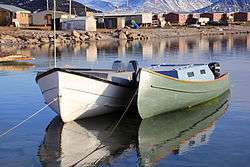 Qikiqtarjuaq in 2011 | |
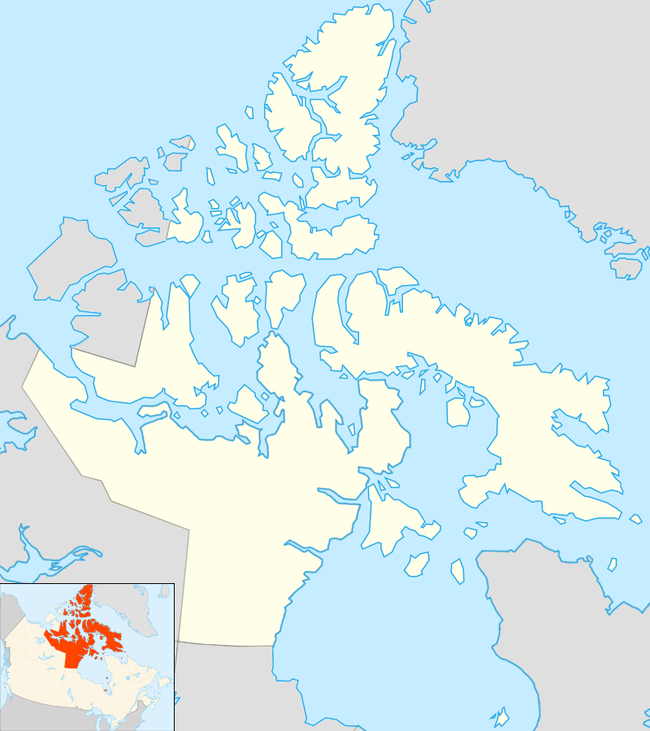 Qikiqtarjuaq  Qikiqtarjuaq | |
| Coordinates: 67°33′29″N 064°01′29″W | |
| Country | Canada |
| Territory | Nunavut |
| Region | Qikiqtaaluk |
| Electoral district | Uqqummiut |
| Government | |
| • Type | Hamlet Council |
| • Mayor | Harry Alookie |
| • MLAs | Pauloosie Keyootak |
| Area | |
| • Total | 130.71 km2 (50.47 sq mi) |
| Elevation | 6 m (20 ft) |
| Population (2016)[3] | |
| • Total | 598 |
| • Density | 4.6/km2 (12/sq mi) |
| Time zone | UTC−05:00 (EST) |
| • Summer (DST) | UTC−04:00 (EDT) |
| Canadian Postal code | X0A 0B0 |
| Area code(s) | 867 |
At the 2016 census the population was 598, an increase of 15.0% from the 2011 census.[3]
Qikiqtarjuaq hosts an annual "Suicide Prevention Walk".[6] Local participants would walk a total distance of 60 km (37 mi) across the tundra from Kivitoo, an old whaling station.[7] Today the walk is much shorter than the original two and a half days, but it is still meant to promote hope among the community.
The community hosts a two-week celebration over the Christmas and New Year period every year. Visitors are warmly welcomed and encouraged to join the festivities and games.
Near Qikiqtarjuaq was the home of FOX-5, a Distant Early Warning Line and now a North Warning System site.
In July 2011, Qikiqtarjuaq was featured in the BBC Radio 4 comedy series Cabin Pressure.
Geography
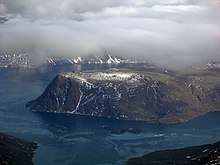
Qikiqtarjuaq is situated off eastern Baffin Island. Davis Strait and Baffin Bay run to the east, and the Baffin Mountains are located to the west, more specifically the Arctic Cordillera mountain range. It is also one of the Nunavut communities closest to Greenland.
Services
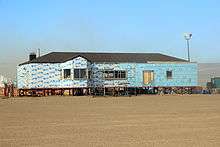

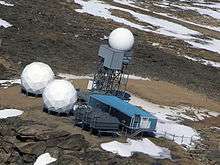
It is served by Qikiqtarjuaq Airport, IATA: YVM, ICAO: CYVM, and a nine-room inn, the Tulugak Hotel. A nursing station and Royal Canadian Mounted Police (RCMP) detachment provide vital resources for the community. The nursing station is composed of two nurses plus local volunteers and assistants and the RCMP station is a one-person detachment but sometimes hosts two officers.
Qikiqtarjuaq is a popular stop for pilots who fly smaller aircraft to and from Europe. The airport has a 3,803 by 100 ft (1,159 by 30 m) gravel runway that is well compacted, well cared for, cleared of snow daily, and lit. Qikiqtarjuaq is considerably closer to Kangerlussuaq, Greenland than Iqaluit (CYFB). The instrument approach minima for the non-directional beacon (NDB) approach at CYVM is relatively high (2,000 feet barometric, 1,982 AGL) due to high terrain surrounding the airport. An airport advisory service, Qikiqtarjuaq Airport Radio, (a Community Airport Radio Station [CARS]) provides assistance to pilots during normal business hours, and provides weather observation services. An automatic weather observation service (AWOS) operates when Qikiqtarjuaq Radio is unattended. The fuel supplier at the airport can assist with all ground handling arrangements, including transportation, parking, de-icing, and accommodations.
In the summer of 2010, construction began on the new airport terminal building, and a new municipal office will be built in 2011. There is also an access road that was built to Tisunaaq, also known as Ceetee Land to the Elders, and another road is proposed to Qikiqtarjuaqruluk, or Old Broughton, an abandoned settlement. Kivitoo, an old whaling station, is located 90 km (56 mi) to the north and is currently abandoned.
Broadband communications
The community has been served by the Qiniq network since 2005. Qiniq is a fixed wireless service to homes and businesses, connecting to the outside world via a satellite backbone. The Qiniq network is designed and operated by SSI Micro. In 2017, the network was upgraded to 4G LTE technology, and 2G-GSM for mobile voice.
Climate
Qikiqtarjuaq has a tundra climate, with the warmest month averaging below 6 °C (43 °F).
| Climate data for FOX-5 | |||||||||||||
|---|---|---|---|---|---|---|---|---|---|---|---|---|---|
| Month | Jan | Feb | Mar | Apr | May | Jun | Jul | Aug | Sep | Oct | Nov | Dec | Year |
| Record high humidex | 1.5 | 0.0 | 2.7 | 6.1 | 8.6 | 18.6 | 20.7 | 19.9 | 13.6 | 7.0 | 3.5 | 3.9 | 20.7 |
| Record high °C (°F) | 3.9 (39.0) |
1.1 (34.0) |
4.0 (39.2) |
7.8 (46.0) |
14.2 (57.6) |
17.8 (64.0) |
20.7 (69.3) |
22.6 (72.7) |
14.4 (57.9) |
10.6 (51.1) |
7.5 (45.5) |
5.0 (41.0) |
22.6 (72.7) |
| Average high °C (°F) | −22.8 (−9.0) |
−22.4 (−8.3) |
−19.6 (−3.3) |
−13.6 (7.5) |
−5.4 (22.3) |
2.8 (37.0) |
8.2 (46.8) |
6.3 (43.3) |
−0.1 (31.8) |
−4.9 (23.2) |
−11.9 (10.6) |
−18.5 (−1.3) |
−8.5 (16.7) |
| Daily mean °C (°F) | −25.4 (−13.7) |
−25.2 (−13.4) |
−22.9 (−9.2) |
−16.9 (1.6) |
−8.2 (17.2) |
0.2 (32.4) |
5.3 (41.5) |
3.7 (38.7) |
−1.9 (28.6) |
−6.9 (19.6) |
−14.2 (6.4) |
−21.1 (−6.0) |
−11.1 (12.0) |
| Average low °C (°F) | −28.0 (−18.4) |
−28.0 (−18.4) |
−26.1 (−15.0) |
−20.2 (−4.4) |
−10.9 (12.4) |
−2.4 (27.7) |
2.4 (36.3) |
1.1 (34.0) |
−3.8 (25.2) |
−9.0 (15.8) |
−16.6 (2.1) |
−23.7 (−10.7) |
−13.8 (7.2) |
| Record low °C (°F) | −41.7 (−43.1) |
−42.8 (−45.0) |
−40.7 (−41.3) |
−34.3 (−29.7) |
−26.1 (−15.0) |
−12.2 (10.0) |
−8.9 (16.0) |
−7.8 (18.0) |
−13.9 (7.0) |
−24.4 (−11.9) |
−33.3 (−27.9) |
−39.2 (−38.6) |
−42.8 (−45.0) |
| Record low wind chill | −61.1 | −61.0 | −57.1 | −49.2 | −35.8 | −21.1 | −18.6 | −15.5 | −23.9 | −32.8 | −45.2 | −54.2 | −61.1 |
| Average precipitation mm (inches) | 3.7 (0.15) |
6.1 (0.24) |
3.6 (0.14) |
12.7 (0.50) |
23.7 (0.93) |
10.2 (0.40) |
18.1 (0.71) |
24.2 (0.95) |
30.0 (1.18) |
36.7 (1.44) |
29.7 (1.17) |
4.7 (0.19) |
203.3 (8.00) |
| Average rainfall mm (inches) | 0.0 (0.0) |
0.0 (0.0) |
0.0 (0.0) |
0.0 (0.0) |
0.0 (0.0) |
0.8 (0.03) |
10.8 (0.43) |
15.7 (0.62) |
2.4 (0.09) |
0.3 (0.01) |
0.0 (0.0) |
0.0 (0.0) |
30.0 (1.18) |
| Average snowfall cm (inches) | 3.7 (1.5) |
6.1 (2.4) |
3.6 (1.4) |
12.7 (5.0) |
23.7 (9.3) |
9.4 (3.7) |
7.3 (2.9) |
8.5 (3.3) |
27.7 (10.9) |
36.3 (14.3) |
29.7 (11.7) |
4.7 (1.9) |
173.3 (68.2) |
| Average precipitation days (≥ 0.2 mm) | 2.9 | 2.8 | 2.5 | 5.0 | 8.2 | 3.9 | 6.3 | 8.2 | 8.3 | 12.8 | 7.4 | 4.1 | 72.3 |
| Average rainy days (≥ 0.2 mm) | 0.0 | 0.0 | 0.0 | 0.0 | 0.0 | 0.5 | 4.8 | 5.2 | 0.6 | 0.2 | 0.0 | 0.0 | 11.2 |
| Average snowy days (≥ 0.2 cm) | 2.9 | 2.8 | 2.5 | 5.0 | 8.2 | 3.3 | 1.7 | 3.1 | 7.7 | 12.7 | 7.4 | 4.1 | 61.3 |
| Average relative humidity (%) | 76.6 | 74.7 | 76.6 | 81.5 | 88.0 | 85.5 | 78.4 | 81.5 | 91.2 | 88.7 | 83.7 | 79.2 | 82.1 |
| Source: Environment Canada Canadian Climate Normals 1981–2010[8] | |||||||||||||
See also
References
- Nunavummiut vie for council positions in upcoming hamlet elections
- Nunavut recounts produce one winner and one intractable deadlock
- "Census Profile, 2016 Census". Statistics Canada. Retrieved 3 March 2017.
- Elevation at airport. Canada Flight Supplement. Effective 0901Z 30 January 2020 to 0901Z 26 March 2020.
- "Qikiqtarjuaq". Nunavut Tourism. Retrieved 30 August 2014.
- "NunatsiaqOnline 2013-05-30: NEWS: Suicide prevention in Nunavut: Qikiqtarjuaq walkers show they care". www.nunatsiaqonline.ca. Retrieved 13 February 2017.
- "NTI CA IIBA Phase 1 Draft – Cultural Heritage Resources Report – Akpait & Qaqulluit Project" (PDF). p. 12.
- "Fox Five" (CSV (4222 KB)). Canadian Climate Normals 1981–2010. Environment Canada. Climate ID: 2400570. Retrieved 27 November 2013.
Further reading
- Mallory ML, BM Braune, M Wayland, and KG Drouillard. 2005. "Persistent Organic Pollutants in Marine Birds, Arctic Hare and Ringed Seals Near Qikiqtarjuaq, Nunavut, Canada". Marine Pollution Bulletin. 50, no. 1: 95–101.
- Stuckenberger, Anja Nicole. Community at play social and religious dynamics in the modern Inuit community of Qikiqtarjuaq = Een Samenleving in het Spel : sociale en religieuze Dynamiek in de moderne Inuit Gemeenschap van Qikiqtarjuaq. Amsterdam: Rozenberg, 2005. ISBN 90-5170-957-9
External links
| Wikimedia Commons has media related to Qikiqtarjuaq. |
- The Tulugak Hotel
- Qikiqtarjuaq Facts
- Leelie Enterprises (Airport Fuel Provider, FBO, and Lodge Operator)